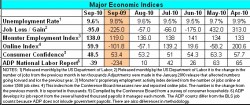 The last jobs report before the mid-term election next month was, like so many since the beginning of the year, a mixed bag. Unemployment in September didn’t improve, but it didn’t get worse. Private sector hiring rose by 64,000 jobs, not as much as some economic surveys predicted, but about what others expected. And overall, 95.000 jobs were lost, the result mostly of the layoff of temporary Census workers.
The last jobs report before the mid-term election next month was, like so many since the beginning of the year, a mixed bag. Unemployment in September didn’t improve, but it didn’t get worse. Private sector hiring rose by 64,000 jobs, not as much as some economic surveys predicted, but about what others expected. And overall, 95.000 jobs were lost, the result mostly of the layoff of temporary Census workers.
Depending on which survey you looked at, this morning’s report from the U.S. Bureau of Labor Statistics was pretty much what everyone expected. That the unemployment rate didn’t rise was probably the biggest surprise. Bloomberg’s survey of 83 economists pegged the unemployment rate to rise to 9.7 percent. The Associated Press agreed with that estimate and suggested unemployment might hit 10 percent next year.
Now with the last of the Census workers gone, economists may rejigger their unemployment predictions, especially as other indicators continue to suggest a stabilizing economy. The latest indicator came Thursday, when the Labor Department reported initial claims for unemployment decreased again. Despite plenty of ups and downs in the weekly report over the summer, the numbers are edging down.
Also encouraging was that the BLS reported that most industries added jobs last month; only manufacturing, which lost 6,000 jobs, and construction, the biggest loser at 21,000, continued to lag.
Still, the Associated Press reported that with the unemployment rate at 9.5 percent or more for 14 consecutive months, it has now surpassed the 13-month period from 1982 to 1983 as the longest period of high unemployment since monthly records began in 1948.
And there’s no strong pickup in evidence in the immediate future.
The average workweek in September was 34.2 hours, unchanged from August. Manufacturer workers on average decreased their workweek by .1 hour to 40.1. Factory overtime was also unchanged.
Before employers begin hiring strongly, they typically increase work weeks and add overtime. Not doing so suggests continued slowness and caution. Another early sign is the hiring of temporary workers. This is happening and has been a trend since early in the year. In September 16,900 more temporary workers were added to payrolls.
As the private sector stabilizes, it is now government that’s pulling down the numbers. The 77,000 lost Census jobs in September were the last big numbers stemming from the huge buildup in the early part of the year. But state and local governments are reducing their workforces at a rapid pace as they struggle to balance budgets.
Educators took the biggest hit with the BLS reporting that 57,600 lost their job last month. They accounted for a third of all lost government jobs.
The BLS also revised downward numbers July and August. The change in total nonfarm payroll employment for July went from 54,000 to 66,000 lost jobs, and for August it went from -54,000 to -57,000.